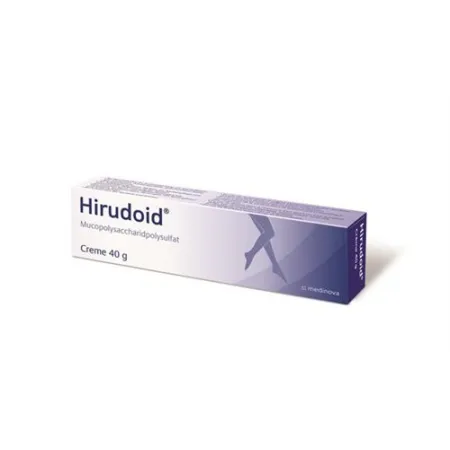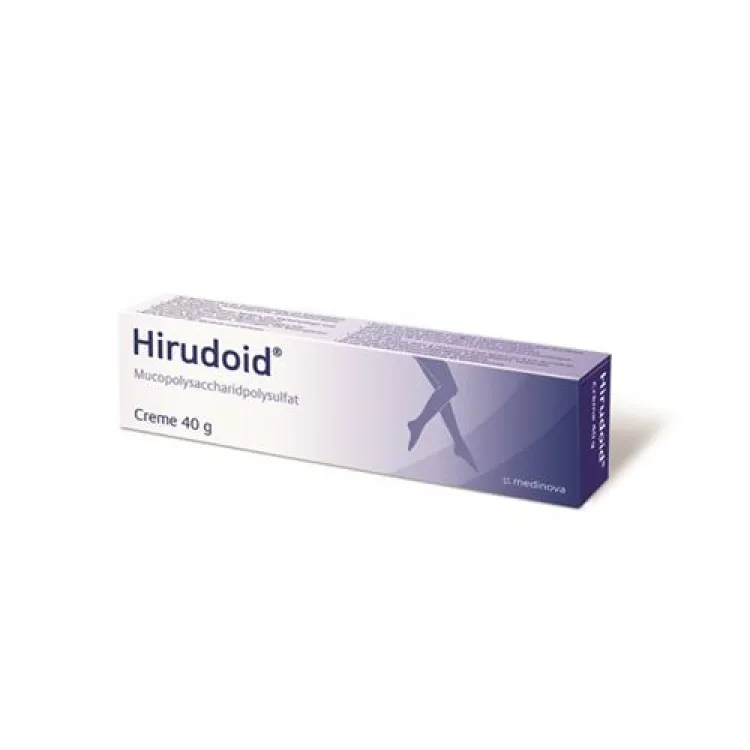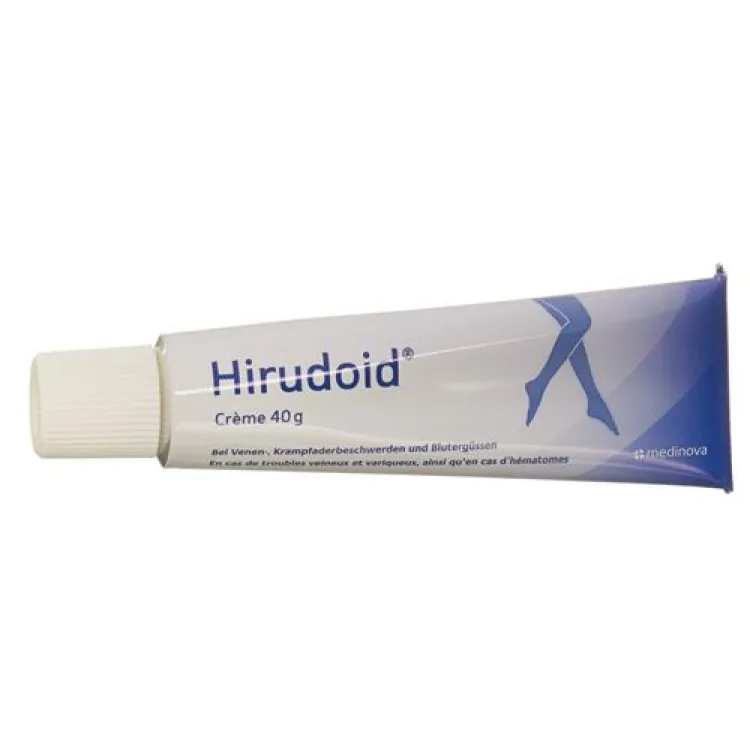Hirudoid Cream 3mg/g tube 40g
Hirudoid Creme 3 mg/g Tb 40 g
-
22.80 USD

- Availability: In stock
- Distributor: MEDINOVA AG
- Brand: Hirudoid
- Product Code: 2731179
- ATC-code C05BA01
- EAN 7680161050583
Ingredients:
Description
Hirudoid cream contains the active ingredient heparinoid MPS (chondroitin polysulphate). MPS is the abbreviation for mucopolysaccharide polysulfate. This active ingredient prevents the formation of blood clots and promotes their regression. In addition, inflammatory processes and fluid accumulations in the tissue are eliminated.
After using Hirudoid Cream, tissue tension and the associated pain are reduced, swelling and bruising are reduced, and the heaviness in the legs is relieved.
Hirudoid cream is applied:
- for complaints associated with varicose veins such as pain, feelings of heaviness, swollen legs (stasis oedema)
- to loosen up hard scars, for scar care and cosmetic improvement of the scars
- for dull scars Sports injuries and accidents such as bruises, contusions, strains, with bruising and swelling
- for muscle and tendon pain
Hirudoid cream can also be used with a doctor's prescription
- for (superficial) phlebitis;
- for inflammatory conditions in varicose veins,
- for follow-up treatment of sclerotherapy;
- for supportive treatment of venous thrombosis
are applied.
Swissmedic-approved patient information
Hirudoid® Creme
What is Hirudoid Creme and when is it used?
Hirudoid Cream contains the active ingredient heparinoid MPS (chondroitin polysulphate). MPS is the abbreviation for mucopolysaccharide polysulfate. This active ingredient prevents the formation of blood clots and promotes their regression. In addition, inflammatory processes and fluid accumulations in the tissue are eliminated.
After using Hirudoid Cream, tissue tension and the associated pain are reduced, swelling and bruising are reduced, and the heaviness in the legs is relieved.
Hirudoid cream is applied:
- for complaints associated with varicose veins such as pain, feelings of heaviness, swollen legs (stasis oedema)
- to loosen up hard scars, for scar care and cosmetic improvement of the scars
- for dull scars Sports injuries and accidents such as bruises, contusions, strains, with bruising and swelling
- for pain in the muscles and tendons
Hirudoid cream can also be used with a doctor's prescription
- for (superficial) phlebitis;
- for inflammatory conditions in varicose veins,
- for follow-up treatment of sclerotherapy;
- for supportive treatment of venous thrombosis
are applied.
What should be considered?
You can support the treatment of your vein disease by making sure you get enough exercise. Sitting or standing for long periods of time causes congestion and strains your veins. Also avoid additional stress such as alcohol and cigarettes in excess, heavy or flatulent food, obesity and overheating from sunbathing and excessive use of the sauna.
Also follow your doctor's advice beyond using Hirudoid, such as exercising or wearing support stockings.
When should Hirudoid Creme not be used?
Hirudoid Creme should not be used in patients with a known hypersensitivity to heparinoid or any of the other excipients.
When is caution required when using Hirudoid Creme?
Hirudoid Creme may only be used on intact skin. Please ensure that the cream does not come into contact with open wounds, eyes or mucous membranes.
In the case of venous diseases that can be traced back to the presence of a blood clot (so-called thromboembolism), massage is not allowed.
This medicinal product contains wool wax alcohol which may cause localized skin irritation (e.g. contact dermatitis).
This medicinal product contains cetostearyl alcohol which may cause localized skin irritation (e.g. contact dermatitis).
This medicinal product contains methyl parahydroxybenzoate (E218) and propyl parahydroxybenzoate (E216), these excipients can cause allergic reactions, including delayed reactions.
If your symptoms persist or if the symptoms worsen, you should definitely see a doctor.
Inform your doctor, pharmacist or druggist if you suffer from other illnesses, have allergies or are taking other medicines (even those you bought yourself!) or using them externally.
Can Hirudoid Cream be used during pregnancy or breastfeeding?
Based on previous experience, there is no known risk to the unborn child if used as directed. However, systematic scientific investigations have never been carried out. As a precaution, you should avoid taking medicines during pregnancy and breastfeeding or ask your doctor, pharmacist or druggist for advice.
How do you use Hirudoid Cream?
Adults
Unless otherwise prescribed by the doctor, several times a day Apply a strand of cream of 3-5 cm (more if necessary) and gently massage in until the cream disappears. In the case of thromboembolic diseases (blood clots), however, massage should not be used.
With the 100 g tube, only about a third of the specified length of the cream strand (d. 1-2 cm) is to be used due to the larger tube opening.
In the case of particularly painful inflammation and thrombosis, the affected area and its surroundings should be carefully coated with cream and covered with bandages. In these cases, the effect of Hirudoid Cream can be intensified by additional rubbing into the area surrounding the diseased tissue area.
To loosen up hard scars, we recommend massaging in the cream vigorously.
Children
The use and safety of Hirudoid cream in children has not been systematically tested.
Stick to the dosage given in the package leaflet or as prescribed by your doctor. If you think the medicine is too weak or too strong, talk to your doctor, pharmacist or druggist.
What side effects can Hirudoid Cream have?
The following side effects can occur when using Hirudoid Cream:
Rare (affects 1 to 10 users in 10,000)
In rare cases, skin hypersensitivity reactions (allergy) may occur.
Tell your doctor or nurse if you notice any of these signs. If the irritation is severe, you should no longer use Hirudoid Cream.
If you notice side effects that are not described here, you should inform your doctor, pharmacist or druggist.
What else needs to be considered?
The medicinal product may only be used up to the date marked «EXP» on the packaging.
Storage instructions
Store at room temperature (15 - 25 °C).
Store medicines in a dry place and out of the reach of children.
Further information
The aluminum foil at the opening of the tube can be easily pierced with the spike embedded in the cap.
Your doctor, pharmacist or druggist can provide you with further information. These people have the detailed information for specialists.
What does Hirudoid cream contain?
1 g of cream contains:
Active ingredients
Heparinoid MPS (chondroitin polysulphate, produced from bovine trachea) 3 mg (equivalent to 250 U.).
Excipients
Glycerol 85%, stearic acid, wool wax alcohols, cetostearyl alcohol, white vaseline, myristyl alcohol, isopropyl alcohol, potassium hydroxide, methyl 4-hydroxybenzoate (E218), thymol, propyl 4-hydroxybenzoate (E216), purified water.
Approval number
16105 (Swissmedic)
Where can you get Hirudoid Cream? What packs are available?
Hirudoid cream is available in pharmacies and drugstores without a doctor's prescription.
There are packs of 40 g and 100 g cream.
Authorization holder
Medinova AG, 8050 Zurich
This leaflet was last checked by the Medicines Agency (Swissmedic) in November 2021.





